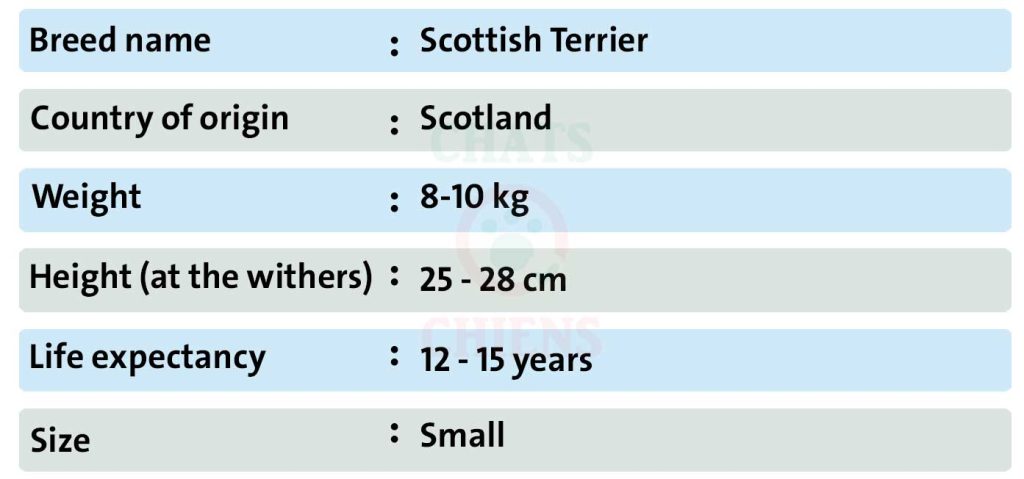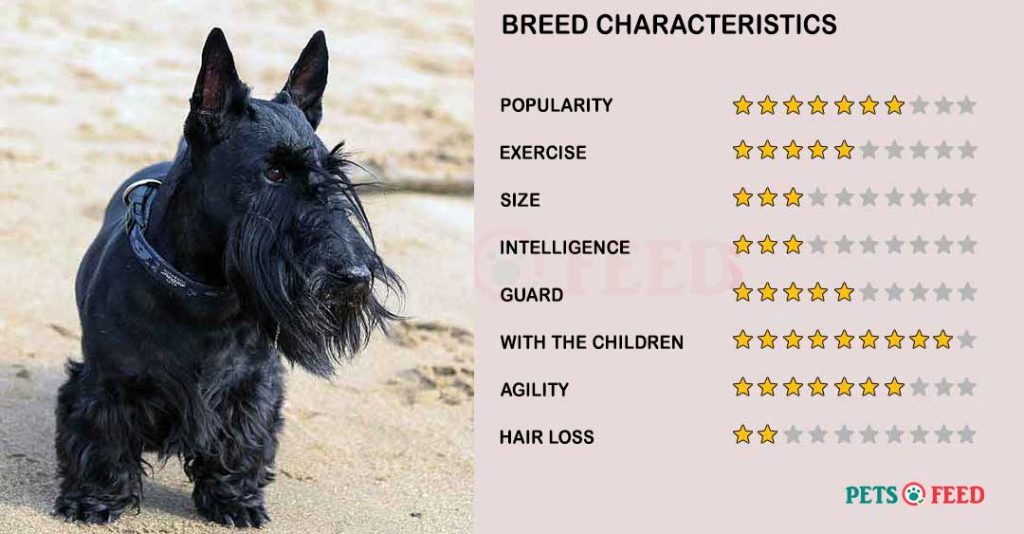The Scottish Terrier, Scottie, or Aberdeenie, is a small muscular dog with strong bones. Its general appearance is that of a very powerful dog for small size. In addition, his characteristic beard gives a special touch to the face of this dog, with an elegant port.
It is a small dog which comes, as its name suggests, from Scotland, and has a fascinating history behind which we will know below.

Scottish Terrier photos
[foogallery id=”44074″]
Physical characteristics
Scottish Terriers, despite their small size, give the impression of being strong and powerful dogs. The outer layer of their coat is heavy and harsh, the undercoat is soft and thick. These dogs have pronounced eyebrows and whiskers. Scottish terriers come in black, wheaten or tabby. The height of adult Scottish terriers is 25-28 cm, and the weight is 8-10 kg.

Distinctive features
- Head: The shape of the skull is elongated, it is almost flat with a pronounced shape.
- Jaws: Characteristic large teeth. The jaws of the Scottish terrier are closed, the upper incisors completely cover the lower row.
- Ears: Slender, pointed, erect.
- Eyes: The dog has a sly look. The shape of the eyes is almond-shaped, the color is rich brown, they are widely set, slightly covered with eyebrows.
- Torso: The broad chest of the Scottish Terrier protrudes forward, slightly lowered downward. The back has a flat, almost horizontal top line. The back itself is not long.
- Legs: The front legs are short, the forearms are straight. The hind legs are larger, the hips are massive, but short. The joints are strong, allowing the dog to jump. The type of paws is arched, the pads are wide. Despite the short legs, the dog is very sturdy. The Scotsman will easily run 10k or dig for an hour or more.
- Coat: The hair is short, adhering perfectly to the body with an undercoat. The longest coat is in the lower region of the body, it creates the “pants” and the “skirt”.
Character and behavior
This dog is courageous, determined and independent, but also very loyal and intelligent. With his family, he tends to be very friendly and playful, although he is independent. With strangers, he tends to be reserved and not easy to make friends, but neither does he tend to be aggressive towards people.
Among the most common behavioral problems in this breed are excessive barking and searching in the garden, in addition to aggression towards other animals.
The Scottish Terrier has the ideal character to be a great pet of people who do not constantly disturb the dog, but who like the physical activities outside.
With the children
Children are treated normally, but sometimes they can show their displeasure if they do not share the desire to play
With other animals
These dogs need early socialization and familiarity with other animals, otherwise they will constantly get into various unpleasant stories.
Health
In general, Scottish Terrier dogs have good immunity and normal genetics. A little apart are “wheaten”, in which the light color is associated with the risk of deafness.
There are also hereditary diseases:
- Endocrine system (hypothyroidism, Cushing’s syndrome),
- Skin (eczema),
- Vision (cataract, progressive tissue atrophy),
- Blood (von Willebrand disease, leukemia, hemophilia),
- Bone system (craniomandibular osteopathy).
Life expectancy
With the right care, the Scottish Terrier can live 12 to 15 years.
Care
The Scottish Terrier needs combing 1-2 times a week, as well as a haircut. The claws are usually trimmed once every 10 days, the animal is bathed 1-2 times a month. Be sure to clean their ears and eyes of dirt and deposits, especially after walking, as the Scottish Terrier likes to climb bushes, look for tracks in the grass, and dig in the ground.
Exercise
As a very active and inquisitive dog, the Scottish Terrier requires a lot of physical and mental exercise. Fortunately, much of this exercise can be done indoors, as these are small dogs. One or more daily walks, added to some games with the ball, are usually enough to channel the energy of these dogs.
The Scottish Terrier needs a minimum of one hour of exercise per day with as much free time as possible, but only in a safe environment taking care when around other dogs.
History of the breed
In the past, all Scottish terriers were divided into only two groups, the short-legged terrier and the long-legged terrier, so that all small breeds crossed. This is a cause of great confusion when researching the origins of the Scottish terrier, and the only thing that is known for certain is that it was used as vermin hunting dog in the Scottish Highlands. Furthermore, he was widely selected to act alone, without the help of farmers, which is why he is now such an independent dog.
By the end of the 19th century, however, a distinction had been made between the different Scottish short-legged terrier dogs and their history is more precisely known. The Scottish terrier was very popular in the Aberdeen area and for a time it was known as the Aberdeen terrier. In 1880, the first breed standard was written and the scottie began to gain popularity on the show tracks.
Between the First and Second World Wars, this breed gained popularity, both as a show dog and as a pet. However, its popularity declined somewhat over the following years. Although not as popular today as it was at its peak, the Scottish Terrier is still a highly regarded pet dog and a major competitor at dog shows.


